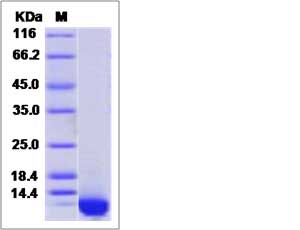Mouse CXCL2 / MIP-2 Protein (His Tag)
CINC-2a,Gro2,GROb,Mgsa-b,MIP-2,MIP-2a,Mip2,Scyb,Scyb2
- 100ug (NPP3411) Please inquiry
| Catalog Number | P50070-M08Y |
|---|---|
| Organism Species | Mouse |
| Host | Yeast |
| Synonyms | CINC-2a,Gro2,GROb,Mgsa-b,MIP-2,MIP-2a,Mip2,Scyb,Scyb2 |
| Molecular Weight | The recombinant mouse Cxcl2 consists of 83 amino acids and predicts a molecular mass of 9.2 kDa. |
| predicted N | Ala 28 |
| SDS-PAGE |  |
| Purity | > 95 % as determined by SDS-PAGE. |
| Protein Construction | A DNA sequence encoding the mouse Cxcl2 (NP_033166.1) (Ala28-Asn100) was expressed with a polyhistidine tag at the C-terminus. |
| Bio-activity | |
| Research Area | Neuroscience |Neurology process |Neuroinflammation |
| Formulation | Lyophilized from sterile 30% CAN. 1. Normally 5 % - 8 % trehalose, mannitol and 0.01% Tween80 are added as protectants before lyophilization. Specific concentrations are included in the hardcopy of COA. |
| Background | Chemokine (C-X-C motif) ligand 2 (CXCL2), also called macrophage inflammatory protein 2 (MIP-2), Growth-regulated protein beta (Gro-beta) and Gro oncogene-2 (Gro-2), is a small cytokine belonging to the CXC chemokine family. CXCL2/MIP-2 is selectively up-regulated in tolerance-conferring APCs and serves to recruit NKT cells to the splenic marginal zone, where they form clusters with APCs and T cells. In the absence of the high-affinity receptor for CXCL2/MIP-2 or in the presence of a blocking Ab to CXCL2/MIP-2, peripheral tolerance is prevented, and Ag-specific T regulatory cells are not generated. CXCL2/MIP-2 is selectively up-regulated in tolerance-conferring APCs and serves to recruit NKT cells to the splenic marginal zone, where they form clusters with APCs and T cells. In the absence of the high-affinity receptor for MIP-2 (as in CXCR2-deficient mice) or in the presence of a blocking Ab to MIP-2, peripheral tolerance is prevented, and Ag-specific T regulatory cells are not generated. Understanding the regulation of lymphocyte traffic during tolerance induction may lead to novel therapies for autoimmunity, graft acceptance, and tumor rejection. Several studies have implicated the CXCL2 chemokine as a mediator in the development of sepsis. CXCL2/MIP-2 also plays a major role in mediating the neutrophilic inflammatory response of the rodent lung to particles such as quartz, crocidolite asbestos, as well as high doses of other relative innocuous dusts such as titanium dioxide. |
| Reference |
